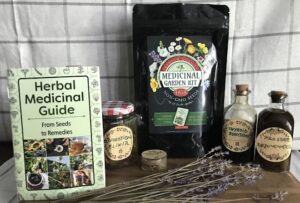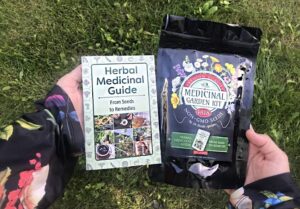Picture this: it’s the middle of winter in the U.S. The days are short, the air feels dry, and fresh herbs at the grocery store cost a fortune—if you can even find them. Meanwhile, your immune system is working overtime to fight off seasonal colds, and the long, dark evenings leave you craving something calming and restorative.
Here’s the good news: you don’t need a big backyard or even a balcony to enjoy the benefits of medicinal herbs this season. With just a sunny windowsill, a few small pots, and a little care, you can create your very own indoor medicine cabinet. Imagine sipping a warm cup of peppermint tea for digestion, or winding down with chamomile before bed, all from herbs you’ve grown yourself—even in the heart of winter.
In this guide, we’ll show you 7 easy-to-grow medicinal herbs that thrive indoors on a windowsill. These plants don’t just brighten up your space; they offer proven health benefits—from boosting immunity and easing stress to soothing sore throats and helping you sleep better.
Whether you’re an apartment dweller in New York, living in a small home in Chicago, or simply someone who wants to try windowsill gardening for the first time, this article is for you. Don’t worry if you’ve never grown a plant before—we’ll walk through everything you need to know, from the right containers and soil to watering tips and light requirements.
By the end, you’ll see just how simple it is to grow powerful, healing plants indoors this winter—and you’ll wonder why you didn’t start sooner. 🌿
Perfect 🌿 Here’s Section 2: Why Grow Medicinal Herbs on Your Windowsill? written in a friendly, authoritative, and beginner-focused tone.
Why Grow Medicinal Herbs on Your Windowsill?
When most people think about growing herbs, they picture a big outdoor garden with rows of plants. But here’s the secret: you don’t need much space at all. A simple windowsill can give you everything you need to create a mini indoor herb garden—and the benefits go far beyond saving a little money at the grocery store.
1. Year-Round Availability
Fresh herbs are often hard to find in stores during winter, and when you do find them, they’re expensive and not always fresh. Growing your own means you’ll have a steady supply of peppermint, chamomile, or thyme all year round—right within arm’s reach.
2. Cost Savings
Think about how much you’ve spent on store-bought teas, supplements, or even essential oils. By planting just a few seeds in small containers, you can harvest leaves for teas, salves, and remedies for months. A single plant often produces far more than you could buy for the same price.
3. Quality Control
When you grow indoors, you control everything: no pesticides, no chemical sprays, no mystery sourcing. You know your herbs are fresh, safe, and completely organic. For many people, that peace of mind is priceless.
4. Perfect for Small Spaces
Apartment in New York? Studio in Chicago? No problem. Windowsill gardening is designed for limited spaces. Most medicinal herbs need just 4–6 hours of indirect light and a 6–8 inch pot to thrive.
5. Mental Health Boost
Research shows that even a small amount of indoor gardening can help reduce stress and improve mood. There’s something soothing about tending to plants during long winter months. Plus, every time you sip tea from your own herbs, you’ll feel a sense of accomplishment.
✅ Growing herbs on your windowsill isn’t just about having plants—it’s about creating a personal wellness space that saves money, supports your health, and brings a little green life into the gray winter season.
Essential Setup for Windowsill Herb Growing
Before you start planting seeds, you’ll need the right setup. Don’t worry—it’s not complicated, and you don’t need expensive equipment. With just a few basic items, your windowsill can become a thriving indoor herb garden all winter long.
1. Choosing the Right Containers
- Size: Most medicinal herbs need pots that are at least 6–8 inches deep. Larger plants like rosemary or sage may need 10–12 inches.
- Drainage is key: Always use containers with drainage holes. Standing water leads to root rot, which is the #1 reason beginners lose plants.
- Material: Terra cotta is best because it allows soil to breathe and prevents waterlogging. Plastic pots work too, but be mindful of overwatering.
- Pro Tip: Place saucers under pots to protect your windowsill, but empty any excess water after 15–20 minutes.
🌿 2. Soil Selection
- Use a high-quality indoor potting mix, not garden soil. Garden soil is too dense and often carries pests.
- For herbs like lavender, thyme, or rosemary, mix in sand or perlite to improve drainage.
- Fertilizing: Feed herbs every 2–3 weeks with a diluted liquid fertilizer. Avoid over-fertilizing, which can reduce the concentration of essential oils (the compounds that give herbs their medicinal power).
🌿 3. Light Requirements
- Most medicinal herbs need 4–6 hours of direct or bright indirect sunlight daily.
- South-facing windows are ideal. East- or west-facing windows also work; north-facing windows are often too dim in winter.
- If natural light is limited (common in northern states), use a simple LED grow light. Position it 6–12 inches above plants and keep it on for 12–14 hours per day.
🌿 4. Watering Techniques
- The golden rule: check before you water. Stick your finger into the soil up to 1 inch—if it’s dry, water; if it’s still damp, wait.
- Always water thoroughly until water drains from the bottom of the pot.
- In winter, herbs grow more slowly, so they’ll need less frequent watering (once or twice a week for most).
- Pro Tip: Water in the morning so plants have time to absorb moisture during daylight hours.
🌿 5. Temperature & Humidity
- Most herbs thrive between 60–70°F. Keep them away from drafty windows or heating vents.
- Indoor heating dries the air, dropping humidity levels to 40–50%. Herbs prefer around 60–70%.
- To fix this:
- Place pots on a tray with pebbles and water (but don’t let pots sit directly in the water).
- Mist plants lightly every few days.
- Or use a small humidifier nearby.
✅ With the right container, soil, light, water, and environment, your herbs will not just survive the winter—they’ll thrive. Think of this setup as your plants’ “indoor home” where they feel safe and supported, just like you during the colder months.
Perfect 🌿 Let’s start Section 4: The 7 Best Medicinal Herbs for Winter Windowsills with Herb #1: Peppermint.
🌱 1. Peppermint – The Digestive Powerhouse
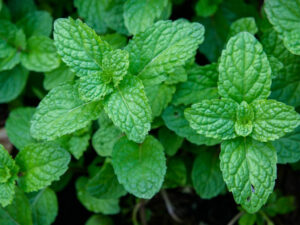
🌿 What It Is
Peppermint (Mentha × piperita) is a hardy perennial from the mint family, created as a natural cross between watermint and spearmint. It’s one of the easiest herbs to grow indoors and adapts well to small pots on your windowsill.
🌿 Medicinal Benefits
- Digestive Aid → Peppermint relaxes the digestive tract muscles, easing gas, bloating, and indigestion (PubMed).
- Headache Relief → Menthol in peppermint can help reduce tension headaches when inhaled or applied topically (NIH – NCCIH).
- Respiratory Support → Helps clear sinuses and ease congestion.
- Antimicrobial → Naturally fights bacteria, fungi, and some viruses, supporting oral and gut health.
🌿 Growing Requirements
- Light: Needs 4–6 hours of bright indirect sunlight or grow light.
- Container: 6–8 inch pot with drainage holes. Peppermint spreads quickly, so keep it in its own pot.
- Soil: Moist, well-draining potting mix enriched with compost.
- Watering: Keep soil evenly moist but not soggy. Avoid letting it dry out completely.
- Temperature: Thrives at 65–70°F indoors.
🌿 How to Use
- Tea: Steep 1–2 teaspoons of dried peppermint leaves (or 5–7 fresh leaves) in hot water for 5–10 minutes. Drink up to 2 cups daily.
- Fresh Use: Chew 3–5 fresh leaves to ease nausea or indigestion.
- Inhalation: Add a few leaves to hot water, cover your head with a towel, and inhale steam to relieve congestion.
🌿 Beginner Tip
Pinch off flower buds as soon as they appear. This keeps the plant focused on producing flavorful leaves rather than flowers.
✅ Peppermint is one of the easiest herbs for beginners—fast-growing, forgiving, and endlessly useful for digestion and headaches.
2. Chamomile – The Calming Classic

What It Is
Chamomile (Matricaria recutita), a daisy-like annual herb, is best known for its small white petals and apple-like fragrance. It’s one of the most popular herbal remedies in the world, and the good news is—it’s simple to grow indoors, even during the coldest months of winter.
🌿 Medicinal Benefits
- Promotes Relaxation & Sleep → Contains apigenin, a compound that binds to receptors in the brain to encourage calmness and better sleep (NIH – NCCIH).
- Anti-Inflammatory → Reduces swelling and supports wound healing (PubMed).
- Digestive Support → Eases indigestion, bloating, and nausea.
- Skin Health → Used topically to soothe irritation, rashes, and minor wounds.
🌿 Growing Requirements
- Light: Needs 4–6 hours of moderate sunlight; a south-facing windowsill is ideal.
- Container: Minimum 6-inch pot with good drainage.
- Soil: Well-draining potting mix; add a little sand for airflow.
- Watering: Keep soil lightly moist but never waterlogged.
- Temperature: Prefers 50–65°F nights; thrives in cool, bright indoor conditions.
🌿 How to Use
- Tea: Steep 1 teaspoon dried chamomile flowers (or 2–3 teaspoons fresh) in hot water for 5–15 minutes. Drink before bed for relaxation.
- Compress: Dip a cloth in cooled chamomile tea and apply to skin irritation.
- Dosage: 1–3 cups daily. ⚠️ Avoid if allergic to ragweed.
🌿 Beginner Tip
Harvest flowers when they’re fully open and dry them immediately. This keeps their medicinal compounds potent and ready for winter tea blends.
✅ Chamomile is one of the best starter herbs—it grows quickly, self-seeds, and gives you a soothing bedtime tea straight from your windowsill.
🌱 3. Thyme – The Immune Protector
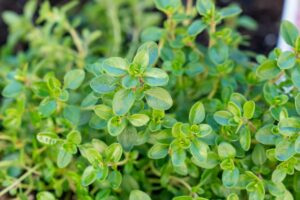
What It Is
Thyme (Thymus vulgaris) is a hardy, low-growing Mediterranean herb with tiny gray-green leaves. Known for its strong aroma and medicinal oils, thyme is both a culinary favorite and a proven natural remedy. Indoors, it thrives on a sunny windowsill and is remarkably easy to care for in winter.
🌿 Medicinal Benefits
- Immune Support → High in Vitamin C and antioxidants, thyme helps strengthen the immune system (Healthline).
- Respiratory Health → Traditionally used for coughs, bronchitis, and sore throats (PubMed).
- Antimicrobial Power → Contains thymol, a compound with natural antibacterial and antifungal properties (Naturopathic Kitchen).
- Anti-Inflammatory → Helps reduce swelling and muscle pain.
🌿 Growing Requirements
- Light: Needs 6+ hours of bright direct light daily (south-facing window ideal).
- Container: 6–8 inch pot with excellent drainage.
- Soil: Sandy, well-draining mix; thyme prefers slightly dry soil.
- Watering: Very drought-tolerant. Water only when the top inch of soil feels dry.
- Temperature: Thrives at 60–70°F, very hardy in cool indoor environments.
🌿 How to Use
- Tea: Steep 1 teaspoon dried thyme leaves in hot water for 5 minutes; drink warm for cough relief.
- Gargle: Use cooled thyme tea as a throat gargle to soothe soreness.
- Culinary: Add 2–3 sprigs of fresh thyme into soups and stews for immune-boosting benefits.
🌿 Beginner Tip
Don’t overwater! Thyme thrives on a “less is more” approach. Too much water is the fastest way to kill this hardy plant indoors.
✅ Thyme is one of the toughest herbs for windowsill gardens—perfect for beginners who want an immune-boosting, respiratory-supporting plant that’s hard to kill.
🌱 4. Rosemary – The Memory Booster
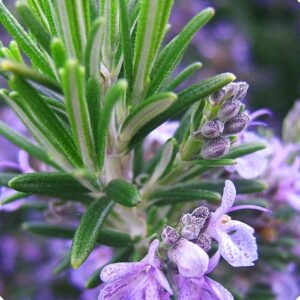
🌿 What It Is
Rosemary (Rosmarinus officinalis) is a fragrant, evergreen Mediterranean shrub with needle-like leaves. While it’s known as a culinary favorite, rosemary also has powerful medicinal benefits. Indoors, it needs more light than some herbs, but with the right spot or a grow light, it makes a fantastic addition to your winter windowsill garden.
🌿 Medicinal Benefits
- Cognitive Support → Research suggests rosemary may improve memory, focus, and mental clarity (PubMed).
- Circulation Booster → Helps improve blood flow and supports heart health (Medical News Today).
- Anti-Inflammatory & Antioxidant → Rich in compounds that protect against oxidative stress and inflammation (Urvann).
- Stress Reduction → Rosemary’s aroma is used in aromatherapy to relieve anxiety and mental fatigue.
🌿 Growing Requirements
- Light: Needs 6–8 hours of bright, direct sunlight daily. If natural light is weak, supplement with a grow light.
- Container: A larger pot (1 gallon or more) to allow root growth.
- Soil: Well-draining, sandy soil mix. Rosemary dislikes “wet feet.”
- Watering: Water deeply but infrequently. Allow the top 2 inches of soil to dry out between waterings.
- Temperature: Prefers 60–65°F nights; keep away from heating vents and radiators.
🌿 How to Use
- Tea: Steep 1 teaspoon fresh rosemary needles in hot water for 5–10 minutes. Drink to improve focus and reduce fatigue.
- Oil: Infuse rosemary sprigs in olive oil for 2 weeks; use as a topical rub for circulation and joint pain.
- Aromatherapy: Place fresh sprigs near your desk or bed to support memory and reduce stress.
🌿 Beginner Tip
Rosemary can be fussy indoors. To avoid problems, don’t overwater and make sure it gets as much light as possible. A grow light can make the difference between a struggling plant and a thriving one.
✅ Rosemary is the brain-boosting herb your windowsill garden needs—perfect for tea, oil infusions, and even keeping your winter cooking flavorful.
🌱 5. Lavender – The Stress Reliever
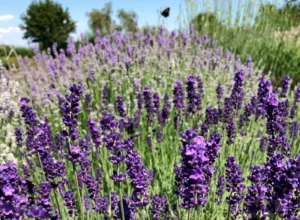
🌿 What It Is
Lavender (Lavandula angustifolia) is a fragrant Mediterranean herb with purple flowers and silvery-green leaves, well known for its calming aroma. While lavender is traditionally grown outdoors, compact varieties adapt well to indoor pots if you provide enough light and air circulation. It’s one of the most rewarding herbs to grow indoors because of both its beauty and its medicinal value.
🌿 Medicinal Benefits
- Stress & Anxiety Reduction → Lavender’s aroma is scientifically proven to reduce anxiety and promote relaxation (NIH – NCCIH).
- Better Sleep → Used in teas, sachets, and aromatherapy to support restful sleep and reduce insomnia (Medical News Today).
- Pain Relief → Lavender oil applied topically can reduce muscle aches and tension headaches (PubMed).
- Antimicrobial Properties → Natural defense against bacteria and fungi, making it useful for minor skin irritations.
🌿 Growing Requirements
- Light: Needs 6+ hours of bright sunlight daily. Often requires a supplemental grow light in winter.
- Container: 8–10 inch pot with excellent drainage (lavender hates soggy soil).
- Soil: Sandy, alkaline soil—add lime if needed to raise pH.
- Watering: Let soil dry out between waterings. Overwatering is the most common mistake.
- Temperature: Prefers cool nights (50–60°F) and good airflow around the plant.
🌿 How to Use
- Tea: Steep 1 teaspoon dried lavender flowers in hot water for 5 minutes. Drink before bedtime to relax.
- Sachets: Place dried lavender in a cloth bag and keep under your pillow to improve sleep.
- Topical Oil: Dilute lavender essential oil in a carrier oil and apply to sore muscles or temples for tension relief.
🌿 Beginner Tip
Lavender can be tricky indoors—don’t overwater and give it as much light as possible. A small fan nearby helps keep air moving and prevents fungal problems.
✅ Lavender is the ultimate calming herb, turning your windowsill into both a healing garden and a natural aromatherapy spa.
🌱 6. Lemon Balm – The Mood Booster
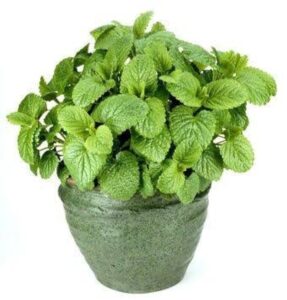
🌿 What It Is
Lemon Balm (Melissa officinalis) is a member of the mint family with soft, heart-shaped leaves and a refreshing citrus scent. It’s one of the easiest herbs to grow indoors on a windowsill because it adapts well to containers and doesn’t demand full sun. Its gentle flavor and calming properties make it a favorite in teas and natural remedies.
🌿 Medicinal Benefits
- Calms the Nervous System → Traditionally used to reduce stress and mild anxiety (Healthline).
- Supports Sleep → Research suggests lemon balm combined with chamomile can help ease insomnia (NIH – NCCIH).
- Digestive Aid → Helps relieve indigestion, bloating, and stomach cramps.
- Antiviral Properties → Particularly noted for its effectiveness against cold sores caused by herpes simplex virus (PubMed).
🌿 Growing Requirements
- Light: Prefers 4–6 hours of indirect sunlight. Tolerates partial shade, making it perfect for less sunny windows.
- Container: Use its own pot (6–8 inches deep) since it spreads quickly like mint.
- Soil: Moist, well-draining potting mix.
- Watering: Keep soil consistently moist but not soggy. Lemon balm wilts quickly if it dries out.
- Temperature: Thrives at 60–70°F indoors.
🌿 How to Use
- Tea: Steep 2–3 fresh leaves (or 1 teaspoon dried) in hot water for 5–10 minutes. Drink to relax or aid digestion.
- Topical: Rub crushed fresh leaves gently on cold sores for soothing relief.
- Culinary: Chop fresh leaves into fruit salads, desserts, or infused water for a refreshing lemony flavor.
🌿 Beginner Tip
Pinch back stems regularly to encourage bushier growth. If left untrimmed, lemon balm can grow leggy and lose flavor.
✅ Lemon balm is one of the best beginner herbs for winter—it’s forgiving, fragrant, and a natural mood-lifter that adds brightness to your windowsill garden.
🌱 7. Sage – The Cognitive & Immune Supporter
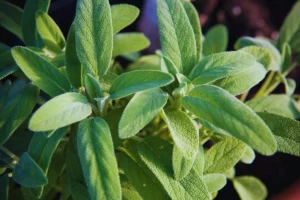
🌿 What It Is
Sage (Salvia officinalis) is a hardy, evergreen herb with soft gray-green leaves and a strong, earthy aroma. While many know sage as a kitchen staple, it also carries a long history of use in traditional medicine. Best of all, it’s resilient and adapts well to indoor container growing, making it an ideal choice for winter windowsill gardens.
🌿 Medicinal Benefits
- Cognitive Health → Studies show sage may enhance memory and mental clarity, even in people with Alzheimer’s disease (PubMed).
- Antimicrobial Properties → Natural defense against bacteria, fungi, and viruses (NIH – NCCIH).
- Sore Throat Relief → Sage tea or gargles soothe sore throats and gum inflammation.
- Digestive Aid → Supports appetite, reduces indigestion, and helps break down fatty foods.
🌿 Growing Requirements
- Light: Needs 6+ hours of direct sunlight or strong grow light.
- Container: 8–10 inch pot to give its roots room to expand.
- Soil: Well-draining, slightly sandy or alkaline mix.
- Watering: Sage is drought-tolerant—let soil dry between waterings.
- Temperature: Prefers 60–70°F, but can tolerate cooler windowsills.
🌿 How to Use
- Tea: Steep 1 teaspoon dried sage leaves in hot water for 10 minutes. Sip to ease sore throats or aid digestion.
- Gargle: Make a stronger tea and gargle warm for mouth infections or throat pain.
- Culinary: Use fresh leaves in soups, poultry, or fatty dishes to improve digestion.
🌿 Beginner Tip
Choose the ‘Berggarten’ variety for container growing. It stays compact, grows well indoors, and produces flavorful leaves year-round.
✅ Sage is the resilient multitasker of your windowsill garden—easy to care for, useful in the kitchen, and powerful as a natural remedy.
| Herb | Light Needs | Container Size | Primary Medicinal Use | Beginner Tip |
|---|---|---|---|---|
| Peppermint | 4–6 hrs indirect light | 6–8 inch pot | Digestive aid, nausea, headache relief | Keep in its own pot—it spreads fast |
| Chamomile | 4–6 hrs moderate light | 6-inch pot | Relaxation, sleep, anti-inflammatory | Harvest flowers when fully open |
| Thyme | 6+ hrs direct light | 6–8 inch pot | Immune support, cough relief | Don’t overwater—thyme likes it dry |
| Rosemary | 6–8 hrs direct light | 1-gallon pot | Memory, circulation, stress relief | Needs strong light or a grow lamp |
| Lavender | 6+ hrs direct light | 8–10 inch pot | Stress & anxiety relief, sleep aid | Allow soil to dry—hates soggy roots |
| Lemon Balm | 4–6 hrs indirect light | 6–8 inch pot | Mood boost, antiviral, digestion | Pinch stems for bushier growth |
| Sage | 6+ hrs direct light | 8–10 inch pot | Memory support, throat relief | Choose ‘Berggarten’ variety for pots |
🍵 Simple Homemade Remedies
One of the most exciting parts of growing medicinal herbs is being able to turn them into practical, everyday remedies right from your windowsill. Even as a beginner, you can create teas, tinctures, and oils that support your health during the long winter months. Here are some simple methods anyone can try:
🍵 1. Basic Herbal Tea Preparation
The easiest and most common way to use your herbs is as tea. Herbal teas can help with everything from stress and sleep to digestion and sore throats.
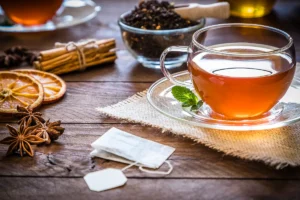
How to Make Herbal Tea:
- Fresh herbs → Use 1 tablespoon chopped leaves or flowers per cup.
- Dried herbs → Use 1 teaspoon per cup.
- Water temperature → Just off boiling, around 195°F.
- Steep time → Cover and steep for 5–10 minutes.
- Drink → Strain and enjoy, adding honey if desired.
Examples:
- Peppermint tea → Soothes digestion and nausea.
- Chamomile tea → Promotes calm and restful sleep.
- Thyme tea → Supports cough relief and sore throats.
🌿 2. Quick Tincture Method
Tinctures are concentrated liquid extracts that preserve herbs for long-term use. They’re stronger than teas and convenient for daily dosing.
How to Make a Tincture:
- Fill a small jar ½ with fresh herbs (or ¼ with dried herbs).
- Cover with 80-proof alcohol like vodka.
- Seal and store in a dark place, shaking daily for 4–6 weeks.
- Strain into a dark glass dropper bottle.
Dosage: 10–30 drops in water, up to 3 times daily (depending on the herb).
Examples:
- Echinacea tincture → Helps shorten duration of colds.
- Lemon balm tincture → Useful for stress and anxiety relief.
🧴 3. Herbal Oil Infusion
Infused oils are perfect for topical use, especially for skin healing or muscle relaxation.
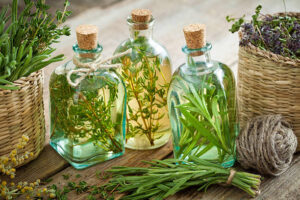
How to Make Herbal Oil:
- Fill a glass jar with fresh or dried herbs.
- Cover completely with olive oil.
- Heat gently using a double boiler for 2–4 hours (or let sit for 2–3 weeks).
- Strain and store in a dark bottle.
Examples:
- Calendula oil → Heals dry skin, minor wounds, and rashes.
- Lavender oil → Reduces muscle tension and supports relaxation.
- Rosemary oil → Improves circulation when massaged into skin.
✅ These remedies are simple, safe, and effective, making them a great starting point for anyone new to herbal medicine. Once you master these basics, you’ll feel empowered to expand into balms, salves, and syrups using the very herbs you grow.
🛠️ Troubleshooting Common Problems
Even with the best setup, it’s normal to run into a few bumps when growing medicinal herbs indoors during winter. The good news? Most problems are easy to fix once you know what to look for. Here are the most common issues windowsill gardeners face—and how to solve them.
💧 1. Overwatering & Root Rot
Problem: The #1 cause of indoor herb failure is overwatering. Roots suffocate in soggy soil, leading to yellowing leaves and drooping stems.
Solution:
- Always check the top 1 inch of soil before watering. If it’s dry, water; if it’s damp, wait.
- Use pots with drainage holes and never let them sit in standing water.
- Herbs like thyme, rosemary, and sage prefer slightly drier soil.
🕷️ 2. Pests Indoors
Problem: Bringing herbs indoors sometimes introduces pests like aphids, spider mites, or fungus gnats.
Solution:
- Inspect plants carefully before moving them indoors.
- If pests appear, wipe leaves with a damp cloth or spray with mild soapy water.
- Place yellow sticky traps in pots to catch fungus gnats.
🌞 3. Not Enough Light
Problem: Herbs grown in dim winter light become leggy, pale, and weak.
Solution:
- Move pots to a south-facing window whenever possible.
- Supplement with a simple LED grow light for 12–14 hours per day if natural light is limited.
- Rotate pots weekly so plants grow evenly.
🌬️ 4. Dry Air from Heating
Problem: Indoor heaters lower humidity to 40–50%, while herbs prefer 60–70%. Leaves may dry out or curl.
Solution:
- Use a humidity tray (a shallow tray with pebbles and water under pots).
- Mist plants lightly every 2–3 days.
- Keep plants away from direct blasts of heating vents.
✂️ 5. Harvesting Too Much, Too Soon
Problem: New gardeners often get excited and pick too many leaves, stunting growth.
Solution:
- Wait until plants are at least 6 inches tall before harvesting.
- Always leave at least ⅔ of the plant intact so it can regrow.
- Harvest herbs in the morning for the highest essential oil content.
✅ With a little observation and quick action, you can easily solve these issues and keep your indoor herb garden thriving all winter long.
🌱 Conclusion: Your Windowsill Medicine Cabinet Awaits
Growing medicinal herbs indoors may sound complicated, but as you’ve seen, all it really takes is a sunny windowsill, a few pots, and a little care. In return, you’ll have year-round access to fresh, natural remedies for sleep, digestion, stress, immunity, and more—all without stepping foot outside in the cold.
The beauty of windowsill gardening is that it fits any lifestyle. Whether you’re in a New York apartment, a Chicago townhouse, or a cozy rural home, these herbs adapt easily to small spaces and limited winter light. Even if you’ve never grown a single plant before, peppermint, chamomile, thyme, rosemary, lavender, lemon balm, and sage are forgiving enough to help you succeed.
So why not start today? Choose just two or three herbs, place them on your windowsill, and within weeks you’ll be enjoying fresh teas, calming aromas, and natural remedies straight from your own mini-garden. 🌿
🌿 Ready to Make It Even Easier?
One challenge beginners often face is finding high-quality seeds and knowing exactly how to grow and use them. That’s where the Medicinal Garden Kit comes in handy.
👉 With this kit, you’ll get:
- 10 heirloom, non-GMO medicinal herb seed packs that thrive indoors and outdoors.
- A step-by-step guidebook showing how to grow, harvest, and turn your herbs into teas, tinctures, and salves.
- Proven varieties like chamomile, echinacea, calendula, lavender, and yarrow—perfect for windowsill or container gardening.
💡 Whether you’re just starting your first indoor herb garden or dreaming of expanding outdoors in the spring, the Medicinal Garden Kit makes the process simple, reliable, and fun.
👉 Click here to start your windowsill medicinal herb garden today with the Medicinal Garden Kit.
